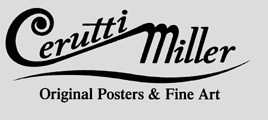 |
42 West 17th Street, 2nd Floor New York, NY 10011 (212) 645-0808 phone (212) 924-7978 fax gallery@ceruttimiller.com www.ceruttimiller.com |
| Works by: |
Leonetto Cappiello Born
in the Italian resort town of Livorno, Cappiello ( 1875 – 1942) had a
natural talent for drawing, and his first ambition was to be a great
painter. He started studying art with a painter’s career in mind, but
meanwhile, purely as a hobby, he would make a quick sketch of anybody
who caught his attention – relatives, home town characters, an
occasional interesting tourist. Soon, he found that these quick
caricatures were always favorably received, and by the time he was 21,
he was able to make a little money by having the best of these homespun
drawings published in booklet form. That
may not have swayed him in itself, but two years later, in 1898, he took
a trip to Paris to visit his older brother who happened to be working
there at the Stock Exchange. Leonetto found Paris intoxicating, and
wanted to put off returning to his sleepy little seaside hometown for a
while; the only way to do it, of course, was by finding a way to support
himself. Why
not utilize his gift for caricature again? His brother told him that
various magazines might pay a good price for caricatures of celebrities,
particularly ones that have not been done to death already. Since that
was true of most of the regular Paris stars, Leonetto approached two
famous visitors who were just then staying in town, and who, being
fellow Italian, might be willing to give an untried kid a break: actor
Ermete Novelli and composer Giacomo Puccini. They obliged, and Leonetto
promptly sold the sketches to Le Rire; they were so well received that
within weeks, he became the favored caricaturist of theater and cabaret
stars of Paris. One
of the major reasons for the quick acceptance of Cappiello was the fact
that his caricatures were never offensive: where other caricaturists
would grossly distort their subjects’ facial features and hold them up
for ridicule, Cappiello used only subtle exaggeration to spotlight their
outstanding characteristics. This gave him access to the one group of
performers who previously fought tooth and nail not to be caricatured:
the prominent ladies of the stage. When they saw that he meant them no
harm, even the most famous names of the day – Sarah Bernhardt, Réjane,
Jeannie Granier – were suddenly willing to sit still for caricatures,
and the young man from Livorno became the darling of the foremost
beauties of Paris. This
prompted Alexandre Natanson, co-publisher of La Revue Blanche, one of
the magazines that had been using his sketches, to commission Cappiello
to publish a portfolio of these drawings under the title “Nos
Actrices” ( “Our Actresses”), which came out in 1899 and launched
his in career in earnest. But
he might have remained a professional illustrator if one of the editors
to whom he routinely submitted sketches had not asked him to prepare a
poster for a new humor magazine he was launching, Le Frou-Frou.
Cappiello used a simple caricature in his usual style – a can-can girl
kicking up her skirts – but now he had to use color, so he opted for a
plain yellow background and a dab of red on the pantaloons peeking out
from under the petticoats. The
poster, prepared so quickly in such a offhand way, made a provocative
splash on the billboards that no passer-by could resist. Instinctively,
Cappiello hit on the right formula: create an eye-catching character and
make a bold, loud statement – and everything else becomes immaterial.
It brought him immediate further offers from various advertisers, and
made him aware of the enormous power of effective communication: he
found the field in which he would labor the rest of his life. His
technique evolved fundamentally from that of British posterists like
Hassel, Hardy and the Beggarstaff Brothers, who used simple drawings and
flat colors – only Cappiello added dynamic zest and dramatic impact
they had never dreamed of. The designs, for the first few attempts, are
firmly rooted in his caricature style; but gradually, he frees his
imagination and begins to develop a poster language even more
compelling. With
few exceptions, Cappiello used two printer-agents for his work: up to
World War I, it was Vercasson, where he developed the principles of his
style; after that, it was Devambez, where he continued to apply them
with an even greater flair and bolder imagination. The key to his
approach was always image association – the idea that you don’t
really remember the image of the product itself, but the image of
something that is associated with the product. Thus, if you are shown
the picture of an old-fashioned phonograph with a listening horn, you
don’t think of any particular brand as it could be any of a dozen
names; but if you see a small white dog listening to it attentively, the
brand name “RCA Victor” will flash to your mind instantly,
involuntarily, because the association had been firmly established
there. Cappiello was the first who thoroughly understood this, and he
applied it with commendable diligence in about a thousand posters. He had an active career which lasted approximately 40 years, during which time he produced an average of two posters per month. Although in such quantity it is inevitable that certain themes and concepts are repeated continually, it is to Cappiello’s credit that his inventiveness never flagged, and he was always able to come up with new ways to shock us, startle us out of our pedestrian complacency, and ultimately delight us. |